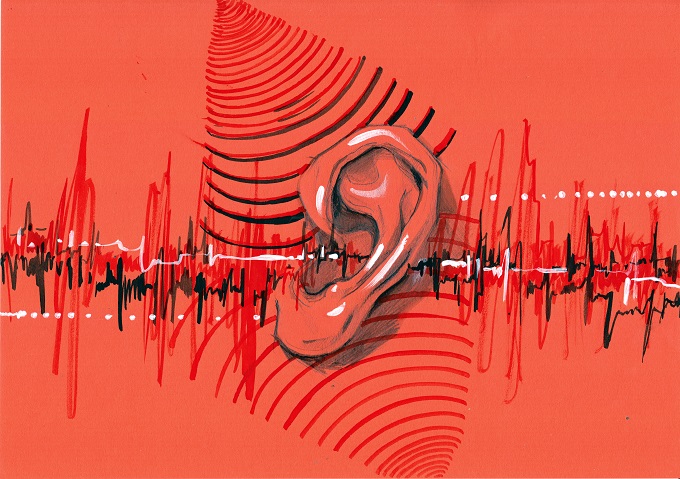
© okalinichenko Images - stock.adobe.com
<h3>How loud is too loud?</h3>
<h2>General consensus from audiologists suggests about 70 to 75 decibels is the safety limit for children, which is the equivalent to the loudness of a vacuum cleaner.</h2>
<p>But Wellington-based audiologist Lisa Seerup warned <em>Newshub</em> that sound levels as low as 50 decibels can cause learning difficulties.</p>
<p>How loud is your classroom? It can be hard to quantify in a school setting, unless ambient noise is actually measured at regular intervals by a professional, because you may not even notice a lot of background noise. Particularly in large rooms like assembly halls, noise builds quickly. Voices travel but technology is an increasing source of classroom noise, whether students are building robots or have VR headsets on. Flexible learning environments encourage lots of furniture moving and foot traffic. Interest in acoustic flooring, insulation and walls is gaining traction as we all become more aware of sensory processing needs.</p>
<p>The World Health Organisation has warned that hearing loss caused by noise is irreversible, so children should be taught to have a healthy listening practice. If students will have their headphones on for an hour-long bus ride, they need noise cancelling headphones so they can keep the volume below 70 percent. </p>
<p>It is a worry that in an age of open-plan layouts and flexible-use environments, the ability to receive and process audible information may have taken a backseat. Noise comes with a cost, according to sound and communication expert and TED talker, Julian Treasure. He said: “If you view teaching as watering the garden, poor acoustics means that some of the water evaporates rather than gets received by the flowers.”</p>
<p>Even in the best environments, good listening is a challenge to humans (we usually only retain 25 percent of information sent) and poor acoustics in a classroom environment will substantially reduce that. Have our country’s schools considered the impact of new trends on acoustics?</p>
<p>Not well enough, according Mr Treasure who said that the type of noise typical in an open plan school environment reduces the learner’s ability to do mental working out significantly, noise has a major effect on cognition and indeed behaviour.</p>
<p>“We teach our children how to read and write, but not how to speak and listen. Listening is untaught and usually unpractised. Our amazing human voice is marginalised as we communicate more and more through text, not spoken word. My vision is to transform the world by inspiring people to listen consciously and speak powerfully.”</p>
<p>At the <em>Sound Education Seminars</em> back in 2012, renowned physicist and acoustician Adrian James revealed how to create better acoustic environments in education. He advocated for educational environments where children can easily listen and he discussed <em>The Essex Study</em>, which showed that acoustically treated rooms lead to less vocal effort from teachers, lower noise levels (primarily for those with hearing impairment, but for all students too), better signal/noise ratio, better behaviour and better learning possibilities.</p>
<p>Creating a good acoustic environment requires knowledge of basic sound minimising strategies and to recognise that each learning environment is acoustically unique (because even if the rooms are identically set up, the acoustics may be very different). He also said schools must consider what teaching method/devices will be used. It is best to consult an expert on this front, who can help to come up with clever ways to minimise ambient noise with different absorption techniques and solutions when a school building is undergoing construction or refurbishment.</p>
<p>There are many ways to improve acoustics, including in-room partitions, soft furnishings and plush coverings, bookshelves and mobile screens, carpet, flooring and wall/ceiling treatments. The MoE’s report, ‘Designing Quality Learning Spaces – Acoustics 2016’ recommends schools: “Use a variety of thicknesses of sound absorption materials. Thin products (less than 50 mm) can provide a good level of absorption at high frequencies, but less absorption at low frequencies.”</p>
<p>It is interesting to note that when referring to flexible learning spaces, the report states: “While sound absorption is very important in flexible learning spaces, sound insulation between learning groups within the space is less critical than it was in traditional classrooms. Users tend to adjust their behaviour through the ‘open-plan office effect’ and high levels of absorption in adjoining spaces lowers the ambient noise levels in both spaces. Together, these reduce the amount of direct sound being created that could interrupt learning activities in an adjacent space.”</p>
<p>For special education learners, consider installing sound reinforcement delivery systems to benefit hearing aids, and make sure that ‘quiet spaces’ or rooms are always available to students who need them.</p>
<p>Listening is a skill like any other: it needs a considered learning environment.</p>

EXCLUSIVE: Teachers used to be paid two to three times more than minimum wage workers,…
After an “overwhelming” vote to reject the latest Government offer, secondary school teachers will begin…
Second-language learning should be compulsory, says a new report from a forum bringing together academics,…
A new entitlement aimed to improve access to learning support coordinators for schools with students…
Educators have raised questions about the Ministry of Education’s new secondary school subjects, set to…
Professional learning and development (PLD) for teachers needs to be higher impact for teachers and…
This website uses cookies.